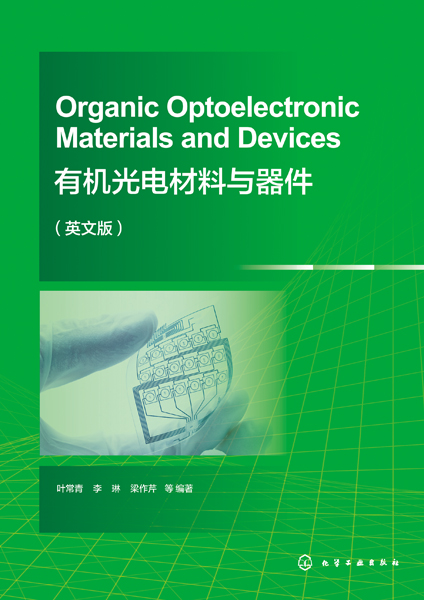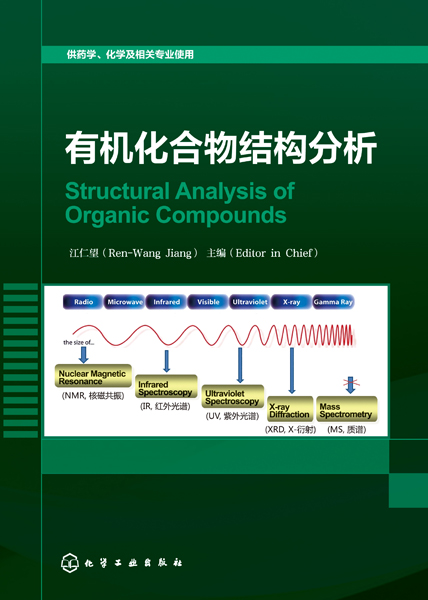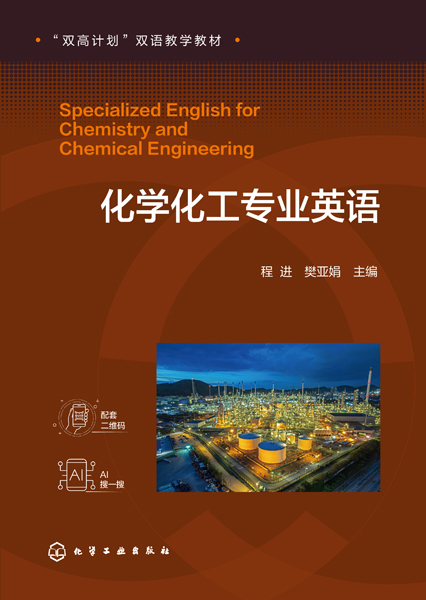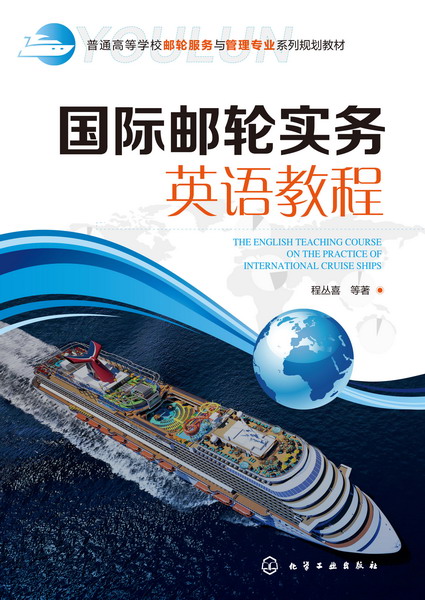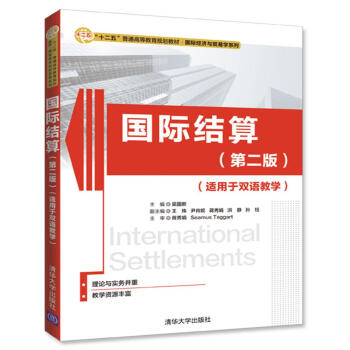有机光电材料与器件(英文版)
定价:¥68.00
作者: 叶常青,李琳,梁作芹等
出版时间:2024-09
出版社:化学工业出版社
- 化学工业出版社
- 9787122455789
- 1版
- 529220
- 16开
- 2024-09
- 292
- 213
- ①TN204
- 研究生及以上
作者简介
目录
Chapter 1 Molecular UV-Vis Absorption Spectrum 1
1.1 Basic Properties of Light 1
1.2 Electron Transition 2
1.2.1 Ground State and Excited State 2
1.2.2 Electron Transition Type 4
1.2.3 Transition Allowed and Transition Forbidden 4
1.3 UV-Vis Absorption Spectrum 6
1.3.1 Absorption Rule 6
1.3.2 Lamber-Beer’s Law 6
1.3.3 UV-Vis Absorption Spectrum 7
1.3.4 UV-Vis Absorption Spectrometer 8
1.4 Factors of Influence on the UV-Vis Absorption Spectrum 8
1.4.1 Basic Concepts 8
1.4.2 Conjugation Effect 11
1.4.3 Steric Effect 13
1.4.4 Solvent Effect 14
1.4.5 Substituent Effect 17
1.4.6 Concentration Effect 18
1.4.7 Absorption Spectrum of Molecular Aggregates 19
1.5 Molecular Structure and Color 20
Chapter 2 Fluorescence Spectra and Fluorescent Sensors 24
2.1 Luminescence 24
2.1.1 Excited State and Decay 24
2.1.2 Singlet State and Triplet State 25
2.1.3 Excited State Decay 25
2.1.4 Fluorescence and Phosphorescence 26
2.1.5 Internal Conversion and Intersystem Crossing 27
2.1.6 Jablonski Diagram 27
2.2 Fluorescence Spectra 28
2.2.1 Fluorescence Emission Spectra 28
2.2.2 Fluorescence Spectrum Characteristics 29
2.2.3 Fluorescence Properties 31
2.3 Factors Influencing Fluorescence Properties 33
2.3.1 Conjugation Effect 33
2.3.2 Planar Effect 34
2.3.3 Substituent Effect 35
2.3.4 Solvent Effect 36
2.3.5 Concentration Effect 39
2.3.6 Other Factors 41
2.4 Phosphorescence Emission 43
2.5 Radiative Energy Transfer and Non-radiative Energy Transfer 44
2.5.1 Radiative Energy Transfer 45
2.5.2 Non-radiative Energy Transfer 48
2.5.3 Stern-Volmer Quenching Equation 49
2.6 Fluorescence Chemical Sensor 51
2.6.1 Structure of Fluorescent Sensing Molecule 51
2.6.2 Signal Expression of Fluorescence Sensor 52
2.6.3 Examples of Fluorescent Sensors 55
Chapter 3 Photochromic and Electrochromic Materials 58
3.1 Photochromism 58
3.1.1 Chromic Materials 58
3.1.2 Photochromism 58
3.1.3 Photochromism Mechanism 58
3.2 Photochromic Materials 59
3.2.1 Azo Derivatives 59
3.2.2 Salicylideneanilines (Schiff’s Base) 62
3.2.3 Diarylethenes 63
3.2.4 Spiropyrans 65
3.3 Photochromic Materials Applications 65
3.3.1 Optical Switches 65
3.3.2 Optical Information Storage 66
3.4 Electrochromic Materials 67
3.4.1 Viologens 68
3.4.2 Polyanilines 69
3.4.3 Metal Phthalocyanines (Phthalocyanine Complexes) 71
3.4.4 Polypyridyl Metal Complexes 74
3.4.5 Electrochromic Parameters 77
3.4.6 Electrochromic Devices 80
3.4.7 Electrochromic Device Applications 82
Chapter 4 Organic Light-emitting Diodes 84
4.1 OLED Research Development 84
4.2 OLEDs Structures 85
4.2.1 Single-layer OLED 86
4.2.2 Multi-layer OLED 87
4.3 OLEDs Product Categories 87
4.4 OLEDs Working Principles 88
4.5 OLEDs Performance Parameters 90
4.6 OLED Materials 93
4.6.1 Organic Luminescent Materials 94
4.6.2 Carrier Transport Materials 97
4.6.3 Electrode Materials of OLEDs 98
4.7 Key Factors on OLED Performances 99
4.7.1 Energy Level Matching 99
4.7.2 Mobility Matching 103
4.8 OLED Production Process 104
Chapter 5 Liquid Crystal Display Materials and Technology 107
5.1 Introduction 107
5.2 Liquid Crystals Classification 108
5.3 Liquid Crystals Chemical Structures 109
5.4 Liquid Crystal Phases 111
5.4.1 Nematic Liquid Crystals 111
5.4.2 Cholesteric Liquid Crystals 111
5.4.3 Smectic Liquid Crystals 112
5.5 Liquid Crystal Domains 112
5.6 Physical Properties 113
5.6.1 LC Temperature Range 114
5.6.2 Viscosity 115
5.6.3 Dielectric Constant 116
5.6.4 Refractive Index 118
5.7 Liquid Crystal Displays 119
5.7.1 Basic Components 119
5.7.2 Working Principle 120
Chapter 6 Organic Field-Effect Transistor Materials and Devices 122
6.1 Field-Effect Transistors 122
6.1.1 Basic Conceptions 122
6.1.2 p-n Junction Semiconductor Diode 124
6.1.3 Semiconductor Triode 125
6.2 Organic Field Effect Transistor 126
6.2.1 OFET Device Structure 126
6.2.2 OFET Working Principle 127
6.3 OFET Performances 128
6.3.1 Device Mobility 128
6.3.2 On/Off Ratio 129
6.3.3 Threshold Voltage 130
6.3.4 Saturation and Unsaturation Regions 130
6.4 OFET Materials 131
6.4.1 Organic Semiconductor Materials 131
6.4.2 Electrode Materials 134
6.4.3 Insulating Layer Materials 136
6.4.4 Substrate Materials 136
6.5 OFET Fabrication Processes 137
6.5.1 Silk-screen Printing 137
6.5.2 Inkjet Printing 138
Chapter 7 Organic Solar Energy Materials and Devices 140
7.1 Solar Spectrum and Solar Energy Utilization 140
7.1.1 Solar Spectrum 140
7.1.2 Solar Energy Utilization 141
7.2 Organic Solar Cell 141
7.2.1 Working Principle 142
7.2.2 Performance Parameters 142
7.2.3 OSC Structures 144
7.2.4 Organic Solar Active Materials 147
7.3 Dye Sensitized Solar Cell (DSSC) 149
7.3.1 Dye Sensitization Principle 149
7.3.2 DSSC Device Structure 150
7.3.3 DSSC Working Principle 151
7.3.4 DSSC Materials 152
7.3.5 Factors influencing DSSCs Performances 155
7.4 Conversion from Solar Energy to Chemical Energy 156
7.4.1 Photosynthesis 156
7.4.2 Conversion of Solar Energy to Hydrogen Energy 158
7.5 Conversion of Solar Energy to Heat 160
Chapter 8 Organic Photoconductors and Devices 162
8.1 Organic Photoconductor Principle 162
8.2 OPC Performance Parameters 163
8.3 OPC Materials 165
8.3.1 Phthalocyanine and Metalphthalocyanine 165
8.3.2 Polyvinylcarbazole 167
8.3.3 PVC Composites 168
8.3.4 Squaraine Dye 170
8.4 OPC Devices 171
8.4.1 OPC Device Composition 171
8.4.2 OPC Device Structure 171
8.4.3 OPC Device Working Principle 172
8.4.4 OPC Device Parameters 172
Chapter 9 Two-photon Absorption Materials and Applications 174
9.1 Two-photon Absorption 174
9.1.1 Nonlinear Optical Phenomena 174
9.1.2 Two-photon Absorption 175
9.2 Two-photon Absorption Applications 175
9.2.1 Optical Power Limiting 176
9.2.2 Two-photon Upconversion Lasing 178
9.2.3 Two-photon Data Storage 180
9.2.4 Two-photon Photodynamic Therapy 182
9.2.5 Two-photon Cofocal Laser Scanning Microscopy (CLSM) 183
9.3 Strong Two-photon Absorption Chromophores 184
9.3.1 Theoretical Molecular Designs 184
9.3.2 Asymmetric Molecular Structures 186
9.3.3 Symmetric Molecular Structures 189
References 192
Chapter 10 Triplet-triplet Annihilation Upconversion Materials and Applications 193
10.1 Triplet-triplet Annihilation Upconversion 193
10.1.1 Differences between TTA-UC and TPA-UC 194
10.1.2 TTA-UC Efficiency 195
10.2 Potential Applications of TTA-UC 198
10.2.1 Upconversion-powered Photoelectrochemistry 198
10.2.2 Upconversion-powered Solar Cell 200
10.2.3 TTA-UC-powered Photolysis of Bilirubin 202
10.3 Triplet-triplet Annihilation Upconversion Systems 203
10.3.1 Solution-based Upconversion Systems 203
10.3.2 Polymer-based Upconversion Systems 208
References 212
1.1 Basic Properties of Light 1
1.2 Electron Transition 2
1.2.1 Ground State and Excited State 2
1.2.2 Electron Transition Type 4
1.2.3 Transition Allowed and Transition Forbidden 4
1.3 UV-Vis Absorption Spectrum 6
1.3.1 Absorption Rule 6
1.3.2 Lamber-Beer’s Law 6
1.3.3 UV-Vis Absorption Spectrum 7
1.3.4 UV-Vis Absorption Spectrometer 8
1.4 Factors of Influence on the UV-Vis Absorption Spectrum 8
1.4.1 Basic Concepts 8
1.4.2 Conjugation Effect 11
1.4.3 Steric Effect 13
1.4.4 Solvent Effect 14
1.4.5 Substituent Effect 17
1.4.6 Concentration Effect 18
1.4.7 Absorption Spectrum of Molecular Aggregates 19
1.5 Molecular Structure and Color 20
Chapter 2 Fluorescence Spectra and Fluorescent Sensors 24
2.1 Luminescence 24
2.1.1 Excited State and Decay 24
2.1.2 Singlet State and Triplet State 25
2.1.3 Excited State Decay 25
2.1.4 Fluorescence and Phosphorescence 26
2.1.5 Internal Conversion and Intersystem Crossing 27
2.1.6 Jablonski Diagram 27
2.2 Fluorescence Spectra 28
2.2.1 Fluorescence Emission Spectra 28
2.2.2 Fluorescence Spectrum Characteristics 29
2.2.3 Fluorescence Properties 31
2.3 Factors Influencing Fluorescence Properties 33
2.3.1 Conjugation Effect 33
2.3.2 Planar Effect 34
2.3.3 Substituent Effect 35
2.3.4 Solvent Effect 36
2.3.5 Concentration Effect 39
2.3.6 Other Factors 41
2.4 Phosphorescence Emission 43
2.5 Radiative Energy Transfer and Non-radiative Energy Transfer 44
2.5.1 Radiative Energy Transfer 45
2.5.2 Non-radiative Energy Transfer 48
2.5.3 Stern-Volmer Quenching Equation 49
2.6 Fluorescence Chemical Sensor 51
2.6.1 Structure of Fluorescent Sensing Molecule 51
2.6.2 Signal Expression of Fluorescence Sensor 52
2.6.3 Examples of Fluorescent Sensors 55
Chapter 3 Photochromic and Electrochromic Materials 58
3.1 Photochromism 58
3.1.1 Chromic Materials 58
3.1.2 Photochromism 58
3.1.3 Photochromism Mechanism 58
3.2 Photochromic Materials 59
3.2.1 Azo Derivatives 59
3.2.2 Salicylideneanilines (Schiff’s Base) 62
3.2.3 Diarylethenes 63
3.2.4 Spiropyrans 65
3.3 Photochromic Materials Applications 65
3.3.1 Optical Switches 65
3.3.2 Optical Information Storage 66
3.4 Electrochromic Materials 67
3.4.1 Viologens 68
3.4.2 Polyanilines 69
3.4.3 Metal Phthalocyanines (Phthalocyanine Complexes) 71
3.4.4 Polypyridyl Metal Complexes 74
3.4.5 Electrochromic Parameters 77
3.4.6 Electrochromic Devices 80
3.4.7 Electrochromic Device Applications 82
Chapter 4 Organic Light-emitting Diodes 84
4.1 OLED Research Development 84
4.2 OLEDs Structures 85
4.2.1 Single-layer OLED 86
4.2.2 Multi-layer OLED 87
4.3 OLEDs Product Categories 87
4.4 OLEDs Working Principles 88
4.5 OLEDs Performance Parameters 90
4.6 OLED Materials 93
4.6.1 Organic Luminescent Materials 94
4.6.2 Carrier Transport Materials 97
4.6.3 Electrode Materials of OLEDs 98
4.7 Key Factors on OLED Performances 99
4.7.1 Energy Level Matching 99
4.7.2 Mobility Matching 103
4.8 OLED Production Process 104
Chapter 5 Liquid Crystal Display Materials and Technology 107
5.1 Introduction 107
5.2 Liquid Crystals Classification 108
5.3 Liquid Crystals Chemical Structures 109
5.4 Liquid Crystal Phases 111
5.4.1 Nematic Liquid Crystals 111
5.4.2 Cholesteric Liquid Crystals 111
5.4.3 Smectic Liquid Crystals 112
5.5 Liquid Crystal Domains 112
5.6 Physical Properties 113
5.6.1 LC Temperature Range 114
5.6.2 Viscosity 115
5.6.3 Dielectric Constant 116
5.6.4 Refractive Index 118
5.7 Liquid Crystal Displays 119
5.7.1 Basic Components 119
5.7.2 Working Principle 120
Chapter 6 Organic Field-Effect Transistor Materials and Devices 122
6.1 Field-Effect Transistors 122
6.1.1 Basic Conceptions 122
6.1.2 p-n Junction Semiconductor Diode 124
6.1.3 Semiconductor Triode 125
6.2 Organic Field Effect Transistor 126
6.2.1 OFET Device Structure 126
6.2.2 OFET Working Principle 127
6.3 OFET Performances 128
6.3.1 Device Mobility 128
6.3.2 On/Off Ratio 129
6.3.3 Threshold Voltage 130
6.3.4 Saturation and Unsaturation Regions 130
6.4 OFET Materials 131
6.4.1 Organic Semiconductor Materials 131
6.4.2 Electrode Materials 134
6.4.3 Insulating Layer Materials 136
6.4.4 Substrate Materials 136
6.5 OFET Fabrication Processes 137
6.5.1 Silk-screen Printing 137
6.5.2 Inkjet Printing 138
Chapter 7 Organic Solar Energy Materials and Devices 140
7.1 Solar Spectrum and Solar Energy Utilization 140
7.1.1 Solar Spectrum 140
7.1.2 Solar Energy Utilization 141
7.2 Organic Solar Cell 141
7.2.1 Working Principle 142
7.2.2 Performance Parameters 142
7.2.3 OSC Structures 144
7.2.4 Organic Solar Active Materials 147
7.3 Dye Sensitized Solar Cell (DSSC) 149
7.3.1 Dye Sensitization Principle 149
7.3.2 DSSC Device Structure 150
7.3.3 DSSC Working Principle 151
7.3.4 DSSC Materials 152
7.3.5 Factors influencing DSSCs Performances 155
7.4 Conversion from Solar Energy to Chemical Energy 156
7.4.1 Photosynthesis 156
7.4.2 Conversion of Solar Energy to Hydrogen Energy 158
7.5 Conversion of Solar Energy to Heat 160
Chapter 8 Organic Photoconductors and Devices 162
8.1 Organic Photoconductor Principle 162
8.2 OPC Performance Parameters 163
8.3 OPC Materials 165
8.3.1 Phthalocyanine and Metalphthalocyanine 165
8.3.2 Polyvinylcarbazole 167
8.3.3 PVC Composites 168
8.3.4 Squaraine Dye 170
8.4 OPC Devices 171
8.4.1 OPC Device Composition 171
8.4.2 OPC Device Structure 171
8.4.3 OPC Device Working Principle 172
8.4.4 OPC Device Parameters 172
Chapter 9 Two-photon Absorption Materials and Applications 174
9.1 Two-photon Absorption 174
9.1.1 Nonlinear Optical Phenomena 174
9.1.2 Two-photon Absorption 175
9.2 Two-photon Absorption Applications 175
9.2.1 Optical Power Limiting 176
9.2.2 Two-photon Upconversion Lasing 178
9.2.3 Two-photon Data Storage 180
9.2.4 Two-photon Photodynamic Therapy 182
9.2.5 Two-photon Cofocal Laser Scanning Microscopy (CLSM) 183
9.3 Strong Two-photon Absorption Chromophores 184
9.3.1 Theoretical Molecular Designs 184
9.3.2 Asymmetric Molecular Structures 186
9.3.3 Symmetric Molecular Structures 189
References 192
Chapter 10 Triplet-triplet Annihilation Upconversion Materials and Applications 193
10.1 Triplet-triplet Annihilation Upconversion 193
10.1.1 Differences between TTA-UC and TPA-UC 194
10.1.2 TTA-UC Efficiency 195
10.2 Potential Applications of TTA-UC 198
10.2.1 Upconversion-powered Photoelectrochemistry 198
10.2.2 Upconversion-powered Solar Cell 200
10.2.3 TTA-UC-powered Photolysis of Bilirubin 202
10.3 Triplet-triplet Annihilation Upconversion Systems 203
10.3.1 Solution-based Upconversion Systems 203
10.3.2 Polymer-based Upconversion Systems 208
References 212

